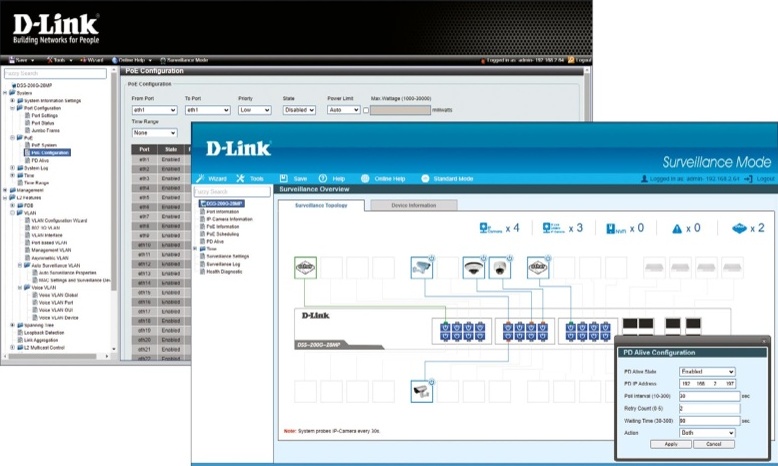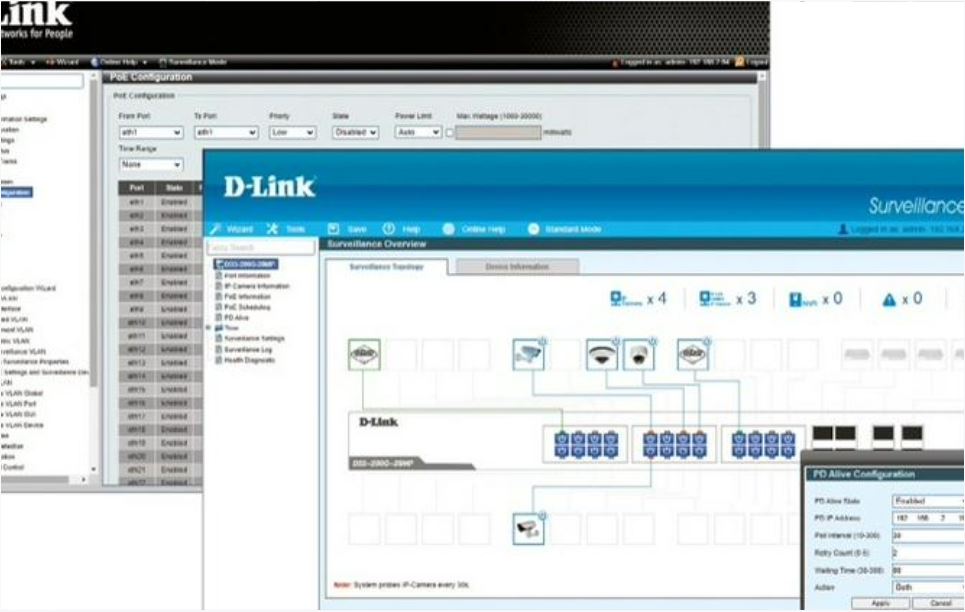Why you can trust TechRadar
This review first appeared in issue 355 of PC Pro.
D-Link is aiming to take surveillance in new directions with its DSS-200G series of Layer 2 switches, which are designed to power the latest IP cameras and provide automated recovery services. This family of four switches is headed up by the 28-port DSS-200G-28MPP, which has a punchy power budget of 518W and offers support for 90W 802.3bt PoE services.
We reviewed the DSS-200G-28MP model, which sits on the rung below and offers a more modest 370W power budget with 30W 803.2at services available across all 24 gigabit ports. Both have four pairs of unpowered copper and fiber dual-personality gigabit ports for uplinks to a network video recorder (NVR) or server.
The switch can power any PoE-compliant device, but D-Link has focused primarily on surveillance usage. It incorporates 6kV surge protection circuitry to shield external cameras against lightning strikes.
One common feature of the DSS-200G series is the block of five DIP switches at the front, which are used to hard-set certain features. The first switch sets an ingress priority function so packets entering port 1 have the highest priority while those incoming on port 24 have the lowest.
The second switch enables a PoE extend mode on the first eight ports. This overcomes the 100-metre PoE cable length limitation by allowing powered devices (PDs) to be placed up to 250 meters away but, in common with all PoE extenders, it drops speed to 10Mbits/sec.
The third switch activates an isolation function so packets incoming on a “controlled” port will only be forwarded to a designated uplink port. This is a handy security feature; it means that if an IP camera is compromised, the intruder can’t gain access to any others attached to the switch.

Next up is D-Link’s PD-Alive function, which pings the IP address of a device to check availability and, if it doesn’t respond for a specific time, will reset its PoE services and send out notifications, although for traps, only the less secure SNMPv2 is supported. Lastly, the fifth DIP switch enables STP, which uses redundant paths to restore connections due to a link failure.
Two management modes are available, and selecting the standard option from the quick start wizard presents a web interface with access to every switch feature. From here, you can configure all Layer 2 functions, create surveillance and voice VLANs, assign one of three PoE priorities to each port and enable the global ONVIF service so all compliant IP cameras are discovered and placed in a separate VLAN.
The surveillance mode presents a completely different interface with a smart graphical topology view showing all ports and attached devices. After we connected three D-Link PoE IP cameras, they were identified and automatically assigned icons with the correct model photo.

Add non-D-Link cameras and, as long as they’re ONVIF-compliant, the switch assigns a generic camera icon but won’t identify their make or model. Devices such as our Netgear Wi-Fi 6 APs were simply classed as “other” but, in all cases, PoE services can be manually recycled to force a remote reboot.
The graphical theme continues with the console offering a filtered view showing only IP cameras along with their IP addresses and power consumption. You can keep a close eye on total power consumption and switch stats from the surveillance overview page, set schedules to control when power is provided to selected ports and configure the PD-Alive function on individual ports instead of using the fourth DIP switch.
The web console is mainly concerned with surveillance functions and offers greatly reduced access to switch settings. This isn’t a problem, though, as you can swap back to the standard mode if you need to tweak something and then return to surveillance mode.
The DSS-200G-28MP is a worthy contender for business surveillance duties as it offers plenty of smart IP camera management and monitoring features. Value looks good, too, as it includes a generous PoE budget, but you’ll need to focus on D-Link’s IP cameras to get the best from it.
Probably the most respected tester of IT equipment in the UK, if you’ve bought a piece of kit for the office - whether printer, server or rack appliance - then you’ve probably read Dave’s verdict at some point along the way.
What is a hands on review?
Hands on reviews' are a journalist's first impressions of a piece of kit based on spending some time with it. It may be just a few moments, or a few hours. The important thing is we have been able to play with it ourselves and can give you some sense of what it's like to use, even if it's only an embryonic view. For more information, see TechRadar's Reviews Guarantee.
You must confirm your public display name before commenting
Please logout and then login again, you will then be prompted to enter your display name.
